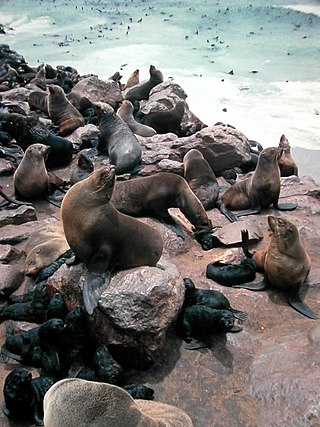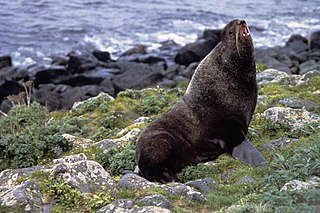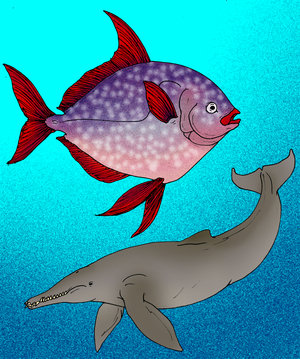
The earless seals, phocids, or true seals are one of the three main groups of mammals within the seal lineage, Pinnipedia. All true seals are members of the family Phocidae. They are sometimes called crawling seals to distinguish them from the fur seals and sea lions of the family Otariidae. Seals live in the oceans of both hemispheres and, with the exception of the more tropical monk seals, are mostly confined to polar, subpolar, and temperate climates. The Baikal seal is the only species of exclusively freshwater seal.

Fur seals are any of nine species of pinnipeds belonging to the subfamily Arctocephalinae in the family Otariidae. They are much more closely related to sea lions than true seals, and share with them external ears (pinnae), relatively long and muscular foreflippers, and the ability to walk on all fours. They are marked by their dense underfur, which made them a long-time object of commercial hunting. Eight species belong to the genus Arctocephalus and are found primarily in the Southern Hemisphere, while a ninth species also sometimes called fur seal, the Northern fur seal, belongs to a different genus and inhabits the North Pacific. The fur seals in Arctocephalus are more closely related to sea lions than they are to the Northern fur seal, but all three groups are more closely related to one another than they are to true seals.

An eared seal, otariid, or otary is any member of the marine mammal family Otariidae, one of three groupings of pinnipeds. They comprise 15 extant species in seven genera and are commonly known either as sea lions or fur seals, distinct from true seals (phocids) and the walrus (odobenids). Otariids are adapted to a semiaquatic lifestyle, feeding and migrating in the water, but breeding and resting on land or ice. They reside in subpolar, temperate, and equatorial waters throughout the Pacific and Southern Oceans, the southern Indian, and Atlantic Oceans. They are conspicuously absent in the north Atlantic.

Sea lions are pinnipeds characterized by external ear flaps, long foreflippers, the ability to walk on all fours, short and thick hair, and a big chest and belly. Together with the fur seals, they make up the family Otariidae, eared seals. The sea lions have six extant and one extinct species in five genera. Their range extends from the subarctic to tropical waters of the global ocean in both the Northern and Southern Hemispheres, with the notable exception of the northern Atlantic Ocean. They have an average lifespan of 20–30 years. A male California sea lion weighs on average about 300 kg (660 lb) and is about 2.4 m (8 ft) long, while the female sea lion weighs 100 kg (220 lb) and is 1.8 m (6 ft) long. The largest sea lions are Steller's sea lions, which can weigh 1,000 kg (2,200 lb) and grow to a length of 3.0 m (10 ft). Sea lions consume large quantities of food at a time and are known to eat about 5–8% of their body weight at a single feeding. Sea lions can move around 16 knots in water and at their fastest they can reach a speed of about 30 knots. Three species, the Australian sea lion, the Galápagos sea lion and the New Zealand sea lion, are listed as endangered.

Pinnipeds, commonly known as seals, are a widely distributed and diverse clade of carnivorous, fin-footed, semiaquatic, mostly marine mammals. They comprise the extant families Odobenidae, Otariidae, and Phocidae, with 34 extant species and more than 50 extinct species described from fossils. While seals were historically thought to have descended from two ancestral lines, molecular evidence supports them as a monophyletic group. Pinnipeds belong to the suborder Caniformia of the order Carnivora; their closest living relatives are musteloids, having diverged about 50 million years ago.

The northern fur seal is an eared seal found along the north Pacific Ocean, the Bering Sea, and the Sea of Okhotsk. It is the largest member of the fur seal subfamily (Arctocephalinae) and the only living species in the genus Callorhinus. A single fossil species, Callorhinus gilmorei, is known from the Pliocene of Japan and western North America.

The genus Arctocephalus consists of the southern fur seals. Arctocephalus translates to "bear head."

Callorhinus is a genus of sea lion. It contains the living northern fur seal (Callorhinus ursinus) as well as the extinct Callorhinus gilmorei and an unnamed species, both from the Pliocene and very beginning of the Pleistocene.

The ribbon seal is a medium-sized pinniped from the true seal family (Phocidae). A seasonally ice-bound species, it is found in the Arctic and Subarctic regions of the North Pacific Ocean, notably in the Bering Sea and Sea of Okhotsk. It is distinguished by its striking coloration, with two wide white strips and two white circles against dark brown or black fur.

Acrophoca longirostris, sometimes called the swan-necked seal, is an extinct genus of Late Miocene pinniped. It was thought to have been the ancestor of the modern leopard seal; however, it is now thought to be a species of monk seal.

Enaliarctos is an extinct genus of pinnipedimorph, and may represent the ancestor to all pinnipeds. The five species in the genus Enaliarctos have been recovered from late Oligocene and early Miocene strata of California and Oregon.
The San Diego Formation is a geologic formation in southwestern San Diego County in southern California, and northwestern Baja California (México).

Waipatia is an extinct genus of odontocetes from the late Oligocene (Chattian) of New Zealand.

Before the 1849 California Gold Rush, American, English and Russian fur hunters were drawn to Spanish California in a California Fur Rush, to exploit its enormous fur resources. Before 1825, these Europeans were drawn to the northern and central California coast to harvest prodigious quantities of southern sea otter and fur seals, and then to the San Francisco Bay Area and Sacramento – San Joaquin River Delta to harvest beaver, river otter, marten, fisher, mink, gray fox, weasel, and harbor seal. It was California's early fur trade, more than any other single factor, that opened up the West, and the San Francisco Bay Area in particular, to world trade.

Orthohalarachne attenuata is a species of mite normally found in the nasal passages of fur seals, sea lions, and walruses. In seals, the mites can be both prevalent and abundant. Although clinical observations and gross examination indicate that O. attenuata parasitization alone is not serious, some erosion and inflammation of the nasal turbinates and nasopharynx in seals has been observed in histological sections. If concomitant parasitization with O. attenuata and O. diminuta occurs, alveolar emphysema and more serious ailments can threaten the life of the mammal.
Pachyphoca is an extinct genus of earless seals from Neogene marine deposits in the northern part of the Paratethys basin.
Annalisa Berta is an American paleontologist and professor emerita in the Department of Biology at San Diego State University.

Monachinae is a subfamily of Phocidae whose distribution is found in the tropical, temperate and polar regions of the southern hemisphere, though in the distant past fossil representatives have been found on both sides of the North Atlantic Ocean. The difference between members of this group and members of Phocinae is in monachines the hindclaws are greatly reduced in size. Furthermore, all species have 34 chromosomes. There are three tribes recognized here: Monachini, Miroungini, and Lobodontini. While today represented by eight extant and one recently extinct species, Monachinae had an incredibly enriched fossil diversity that went into decline soon to be replaced by southern species of sea lions and fur seals.
Kawas is an extinct genus of phocid from the Miocene of Argentina. It contains a single species known as Kawas benegasorum.















